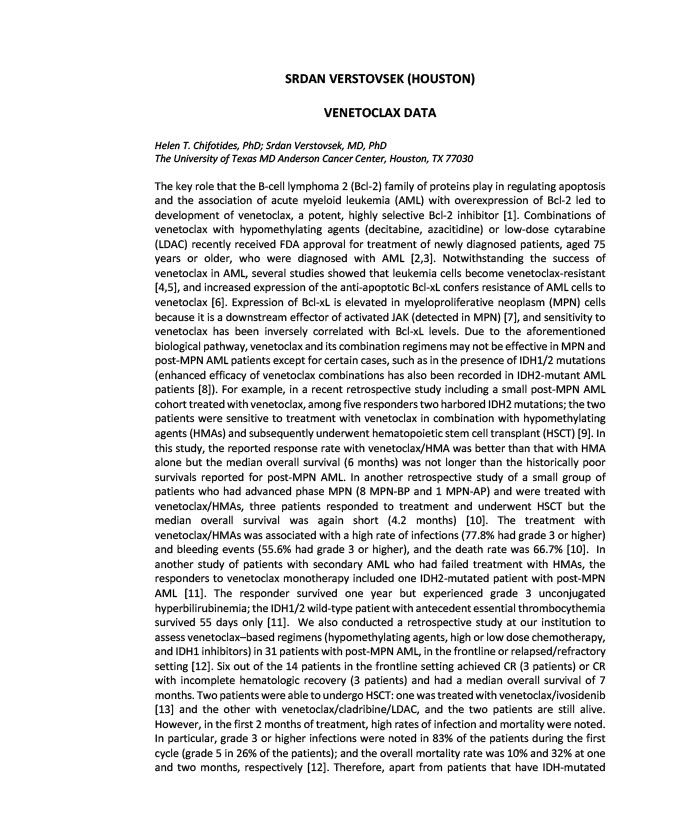
SRDAN VERSTOVSEK (HOUSTON)
VENETOCLAX DATA
Helen T. Chifotides, PhD; Srdan Verstovsek, MD, PhD
The University of Texas MD Anderson Cancer Center, Houston, TX 77030
The key role that the B-cell lymphoma 2 (Bcl-2) family of proteins play in regulating apoptosis
and the association of acute myeloid leukemia (AML) with overexpression of Bcl-2 led to
development of venetoclax, a potent, highly selective Bcl-2 inhibitor 1. Combinations of
venetoclax with hypomethylating agents (decitabine, azacitidine) or low-dose cytarabine
(LDAC) recently received FDA approval for treatment of newly diagnosed patients, aged 75
years or older, who were diagnosed with AML 2,3. Notwithstanding the success of
venetoclax in AML, several studies showed that leukemia cells become venetoclax-resistant
4,5, and increased expression of the anti-apoptotic Bcl-xL confers resistance of AML cells to
venetoclax 6. Expression of Bcl-xL is elevated in myeloproliferative neoplasm (MPN) cells
because it is a downstream effector of activated JAK (detected in MPN) 7, and sensitivity to
venetoclax has been inversely correlated with Bcl-xL levels. Due to the aforementioned
biological pathway, venetoclax and its combination regimens may not be effective in MPN and
post-MPN AML patients except for certain cases, such as in the presence of IDH1/2 mutations
(enhanced efficacy of venetoclax combinations has also been recorded in IDH2-mutant AML
patients 8). For example, in a recent retrospective study including a small post-MPN AML
cohort treated with venetoclax, among five responders two harbored IDH2 mutations; the two
patients were sensitive to treatment with venetoclax in combination with hypomethylating
agents (HMAs) and subsequently underwent hematopoietic stem cell transplant (HSCT) 9. In
this study, the reported response rate with venetoclax/HMA was better than that with HMA
alone but the median overall survival (6 months) was not longer than the historically poor
survivals reported for post-MPN AML. In another retrospective study of a small group of
patients who had advanced phase MPN (8 MPN-BP and 1 MPN-AP) and were treated with
venetoclax/HMAs, three patients responded to treatment and underwent HSCT but the
median overall survival was again short (4.2 months) 10. The treatment with
venetoclax/HMAs was associated with a high rate of infections (77.8% had grade 3 or higher)
and bleeding events (55.6% had grade 3 or higher), and the death rate was 66.7% 10. In
another study of patients with secondary AML who had failed treatment with HMAs, the
responders to venetoclax monotherapy included one IDH2-mutated patient with post-MPN
AML 11. The responder survived one year but experienced grade 3 unconjugated
hyperbilirubinemia; the IDH1/2 wild-type patient with antecedent essential thrombocythemia
survived 55 days only 11. We also conducted a retrospective study at our institution to
assess venetoclax–based regimens (hypomethylating agents, high or low dose chemotherapy,
and IDH1 inhibitors) in 31 patients with post-MPN AML, in the frontline or relapsed/refractory
setting 12. Six out of the 14 patients in the frontline setting achieved CR (3 patients) or CR
with incomplete hematologic recovery (3 patients) and had a median overall survival of 7
months. Two patients were able to undergo HSCT: one was treated with venetoclax/ivosidenib
13 and the other with venetoclax/cladribine/LDAC, and the two patients are still alive.
However, in the first 2 months of treatment, high rates of infection and mortality were noted.
In particular, grade 3 or higher infections were noted in 83% of the patients during the first
cycle (grade 5 in 26% of the patients); and the overall mortality rate was 10% and 32% at one
and two months, respectively 12. Therefore, apart from patients that have IDH-mutated